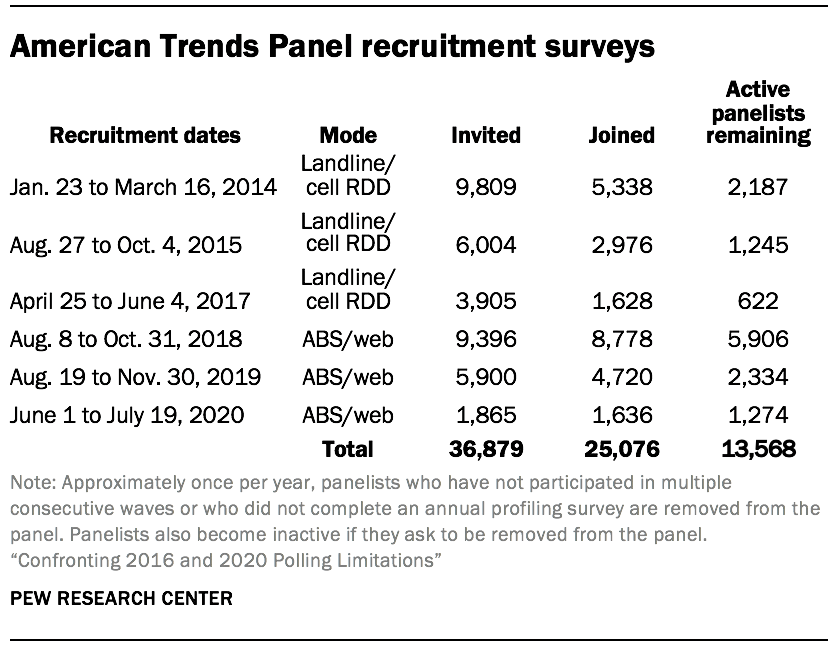The American Trends Panel survey methodology
The American Trends Panel (ATP), created by Pew Research Center, is a nationally representative panel of randomly selected U.S. adults. Panelists participate via self-administered web surveys. Panelists who do not have internet access are provided with a tablet and wireless internet connection. Interviews are conducted in both English and Spanish. The overall target population for ATP surveys is non-institutionalized persons ages 18 and older, living in the U.S., including Alaska and Hawaii. The panel is managed by Ipsos.
Panel recruitment
The ATP was created in 2014, with the first cohort of panelists invited to join the panel at the end of a large, national, landline and cellphone random-digit-dial survey that was conducted in both English and Spanish. Two additional recruitments were conducted using the same method in 2015 and 2017, respectively. Across these three surveys, a total of 19,718 adults were invited to join the ATP, of whom 9,942 (50%) agreed to participate.
In August 2018, the ATP switched from telephone to address-based recruitment. Invitations were sent to a random, address-based sample of households selected from the U.S. Postal Service’s Delivery Sequence File. Two additional recruitments were conducted using the same method in 2019 and 2020, respectively. Across these three address-based recruitments, a total of 17,161 adults were invited to join the ATP, of whom 15,134 (88%) agreed to join the panel and completed an initial profile survey. In each household, the adult with the next birthday was asked to go online to complete a survey, at the end of which they were invited to join the panel. Of the 25,076 individuals who have ever joined the ATP, 13,568 remained active panelists and continued to receive survey invitations at the time the most recent panel wave used in this report was conducted.
The U.S. Postal Service’s Delivery Sequence File has been estimated to cover as much as 98% of the population, although some studies suggest that the coverage could be in the low 90% range.8 The American Trends Panel never uses breakout routers or chains that direct respondents to additional surveys.
Incentives
All respondents are offered a post-paid incentive for their participation in ATP surveys. Respondents can choose to receive the post-paid incentive in the form of a check or a gift code to Amazon.com or could choose to decline the incentive. Incentive amounts range from $5 to $20 depending on whether the respondent belongs to a part of the population that is harder or easier to reach. Differential incentive amounts were designed to increase panel survey participation among groups that traditionally have low survey response propensities.
Data quality checks
To ensure high-quality data, the Center’s researchers perform data quality checks to identify any respondents showing clear patterns of satisficing. This includes checking for very high rates of leaving questions blank, as well as always selecting the first or last answer presented. A small number of individuals were removed from each wave as a result of these checks.
The 2020 ATP recruitment
One section of this report focuses specifically on the 2020 ATP recruitment. That sample was drawn from the U.S. Postal Service Computerized Delivery Sequence File (DSF) and was provided by MSG (Marketing Systems Group). Occupied residential addresses (including “drop points”) in all U.S. states (including Alaska and Hawaii) and the District of Columbia had a nonzero chance of selection. The draw was a national, stratified random sample, with differential probabilities of selection across the mutually exclusive strata. Strata are defined using address-level flags for the likely age, race, and ethnicity of adults living in the household.
Ipsos sent initial mailings in a 9-by-12-inch envelope via first class mail to the sampled households. These packets included two $1 bills and a letter asking a member of the household to complete an online survey using the website and password provided. If two or more adults were in the household, the letter asked the adult with the next birthday to complete the survey. Sampled households were later sent a reminder postcard and then a reminder letter via first class mail.
Households in Hispanic strata received all materials in English and Spanish. All other households received materials in English only. Adults who completed the survey were sent a $10 post-incentive.
Weighting
A detailed description of how ATP surveys are weighted is provided in Appendix A.
© Pew Research Center, 2021





